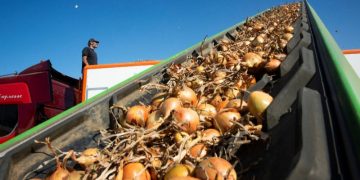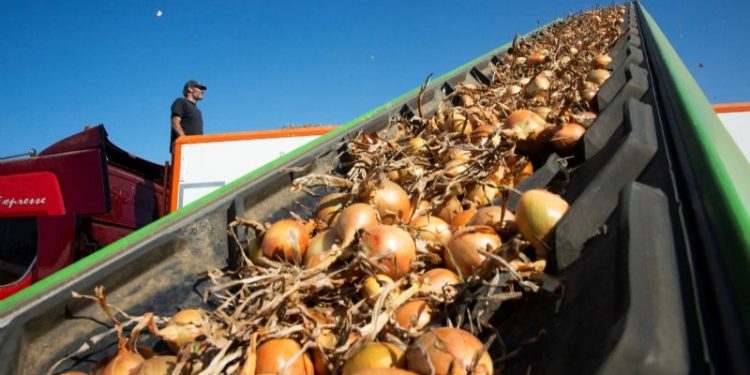If local production is not enough, the Netherlands has the capacity to supply onions anywhere in the world, says Dutch Onion Association (HOA) chairman Gijsbrecht Günther. “The condition is that our onions are affordable. Therefore, we must ensure that production costs are limited throughout the chain, yields are high and quality is excellent.”
Junther spoke about the competitive position of the Netherlands at the onion day of the Northern and Central Netherlands Agricultural Fair in Dronten this week. The President of the Dutch Chamber of Commerce is optimistic about the future. Especially in the first half of the sales season from July to the end of the year, he sees opportunities to increase exports, in particular to African and Asian destinations.
Based on statistics from the FAO World Food Organization, Günther reports that global onion production has doubled over the past twenty years. Of the total production area of 5.8 million hectares in 2021, the Netherlands accounts for just 0.6 percent. Of the total production of about 106 million tons of onions, the share of the Netherlands is 1.5 percent.
Simultaneously with production, there is an almost exponential growth in onion consumption around the world. According to Günther, this is due to population growth. But it’s also because the world’s population is starting to eat more onions. “Twenty years ago, the average consumption was 8 kilograms per person per year, but now it is 13 kilograms and could rise to 20 kilograms in 2050.”
The center of gravity of the growth in consumption and, consequently, the demand for onions is in Asia and Africa. Günther says average consumption in a country like Senegal is 35-40 kilograms per capita. ‘Onions are an important food crop. Especially in regions with strong population growth, onions are on the menu every day.’
According to Günther’s calculations, if the demand really continues, in 2050 onion supplies to the world market will require 180 million tons. At the same time, he notes that onion yields are stagnating around the world due to climate change and that available agricultural area is shrinking. “These developments mean there can sometimes be shortages.”
Günther points out that about 92 percent of the world’s onion production is destined for local markets. So, in essence, the onion trade is mainly focused on local residents. The total export market is currently only 8 percent, or about 8.5 to 9 million tons. The Netherlands accounts for 20 percent of all international onion trade.
First half of marketing season
Given growing demand and supply constraints, Günther concludes that the Netherlands has an opportunity. He expects the greatest demand from Asia and Africa, and therefore Dutch exports will increase even more in the first months of the marketing season. “The ratio of volumes in the first and second half of the marketing season was 40-60, which has now changed to 60-40 and may continue to 70-30.”
According to the HOA chairman, the distinctive character and availability of the Dutch bow is critical to its export position. “Our shelf-stable onions are known for their good quality and excellent keeping quality. But we also need to understand that there are alternatives to supplying onions to the global market, and therefore we should not price our prices outside the market.”
According to Günther, knowing your own cost is essential to being competitive. In addition, when growing, it is important that yields remain high, especially given the ever-increasing contingent costs for farmers. Günther refers, among other things, to a report in which Wageningen University & Research claims that the cost of an average arable farm has increased by 51,000 euros in 2022, or 15 percent.
Influence good yield
In calculating the indicator, Günther shows that with the production of 55 tons per hectare, the cost of onions for Dutch producers is 16 euros per 100 kilograms. This applies to onions that were delivered dry from the barn in December. “Calculating costs is always risky because of the assumptions,” he admits. ‘But if we do the same calculation with a crop of 80 tons, the cost will be 11 euros per 100 kilograms. This shows what the impact of a good harvest is.’































